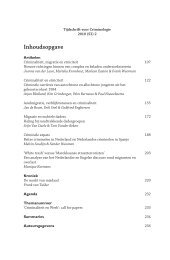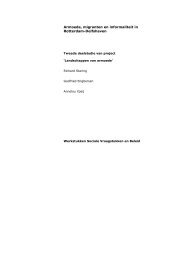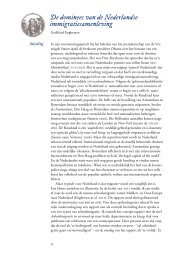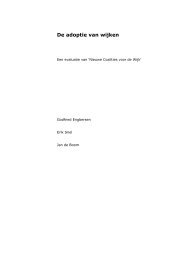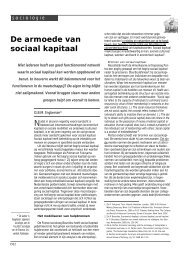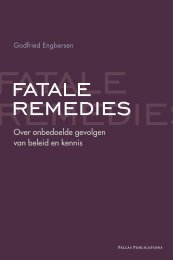THE SOCIAL CONSTRUCTION OF ILLEGALITY AND CRIMINALITY ...
THE SOCIAL CONSTRUCTION OF ILLEGALITY AND CRIMINALITY ...
THE SOCIAL CONSTRUCTION OF ILLEGALITY AND CRIMINALITY ...
Create successful ePaper yourself
Turn your PDF publications into a flip-book with our unique Google optimized e-Paper software.
<strong>THE</strong> <strong>SOCIAL</strong> <strong>CONSTRUCTION</strong> <strong>OF</strong> <strong>ILLEGALITY</strong> <strong>AND</strong> <strong>CRIMINALITY</strong> 3<br />
resulted in a minimum number of 40,000 illegal immigrants for the four<br />
major cities in the Netherlands (Van der Leun et al. 1998; Engbersen et al.<br />
1999).<br />
The irregularisation of migration has raised new research questions as<br />
to the relation between migration and criminality. This is particularly the<br />
case where illegal immigrants are concerned. Two themes are regularly referred<br />
to in this respect. Firstly, the issue of organised migrant trafficking<br />
(Koser 1998) and, secondly, the question of the significance of crime for<br />
groups that are officially excluded from the formal labour market and public<br />
provisions. In this article, we will discuss this second theme, using data<br />
collected within the framework of the Unknown City research project<br />
(Burgers and Engbersen 1999; Engbersen et al. 1999). As part of this research<br />
project conducted from 1993 to 1998, some 170 illegal immigrants<br />
were interviewed, all living in Rotterdam. 2 In addition, an ethnographic<br />
study was carried out to determine to what extent illegal immigrants are<br />
supported by various ethnic communities. 3 Further, we examined the ways<br />
in which the restrictive policies towards illegal immigrants were implemented<br />
by 40 police officers working for the police and the Aliens Departments,<br />
on the one hand, and by 90 professionals within public or<br />
semi-public institutions in the fields of education, healthcare and housing,<br />
on the other. 4 Finally, the files of the Aliens Departments were analysed,<br />
including a Rotterdam file (1989–1994) on 330 apprehensions of illegal<br />
immigrants, which was compared with files on apprehended legal residents,<br />
and a file of all apprehensions of illegal immigrants in the four<br />
major cities in 1995, amounting to a total of nearly 7,000 (Van der Leun<br />
et al. 1998).<br />
2We used a wide variety of search channels and came into contact with people from<br />
the traditional immigrant groups in the Netherlands (Turks, Moroccans, Surnames and<br />
Cape Verdeans) and with illegal immigrants from other countries such as Pakistan and<br />
Ghana. About one quarter of the research group was female. Most respondents were between<br />
20 and 40 years of age. For more details see Burgers and Engbersen (1999).<br />
3We focused on the Turkish community in Rotterdam, the Moroccan community in<br />
Utrecht and the ‘African’ community in Amsterdam, which consists mainly of Ghanaians.<br />
For the sake of clarity we use the word ‘community’ although it is obvious that there<br />
is no such a thing as one single community in these cases. With the help of interviewers<br />
who belonged to these communities we came into contact with 42 Turkish households<br />
(32 legal and 10 illegal), 40 African households (25 legal and 15 illegal) and 39 Moroccan<br />
households (28 legal and 11 illegal), see Engbersen et al. (1999, forthcoming).<br />
4Of these interviews, 30 were held before the introduction of the Linking Act and 60<br />
roughly one year after.



